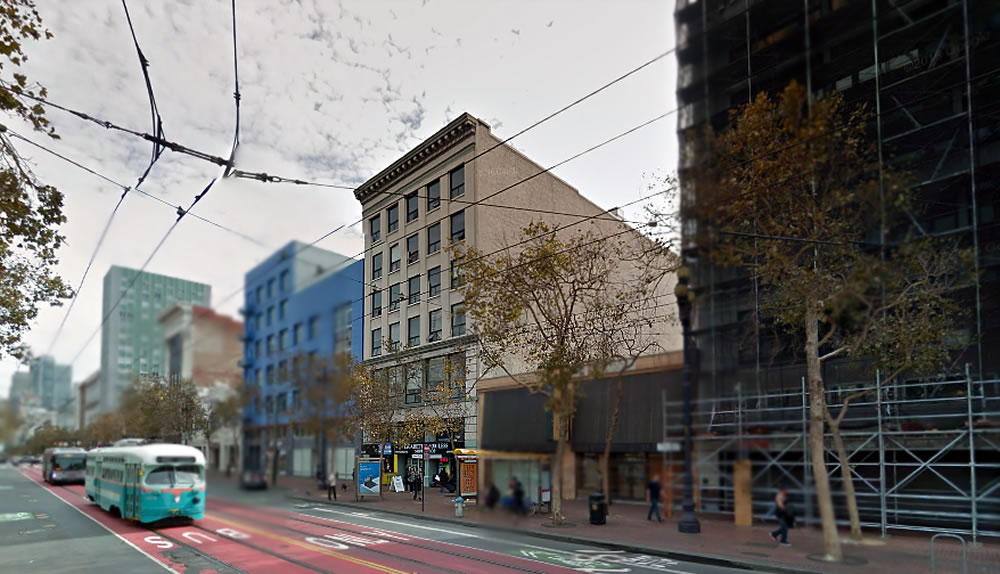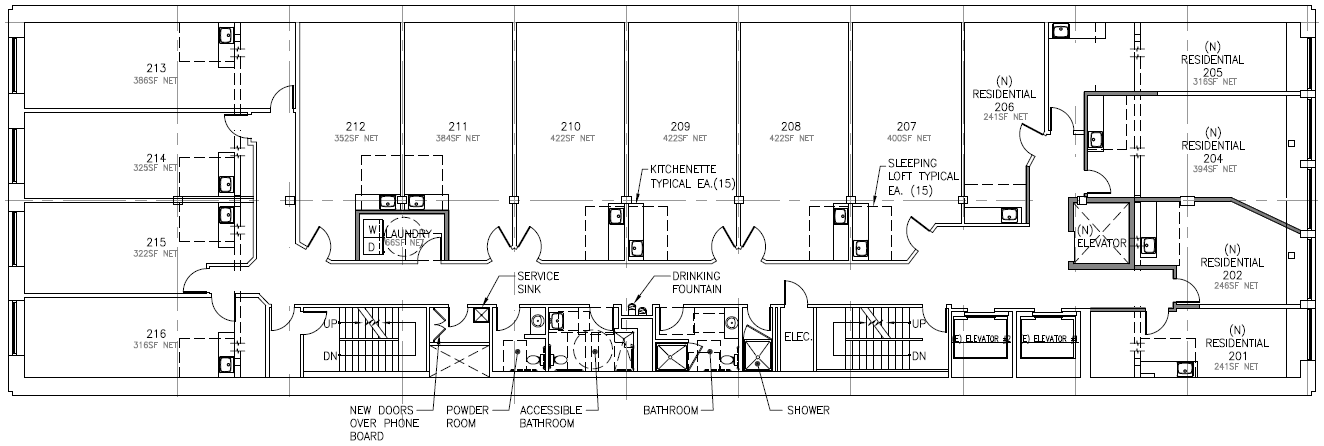The plans to end a nearly eight-year legal and legislative battle between the (now) thirteen remaining residential tenants of the historic Sterling Building at 1049 Market Street, which was illegally converted into a warren of 83 “live-work” spaces over the years, and the building’s owners, who have been trying to evict the rent-controlled tenants, who are mostly artists, since 2013, could be approved this afternoon.
As proposed, the six-story building would be vertically subdivided. The second floor of the building, which would become a standalone parcel, would be sold to The Tenderloin Housing Clinic (THC). And 15 new SRO units would be constructed on the second floor of the building, with shared bathrooms and laundry facilities on the floor but individual kitchenettes in each of the units which would range from 241 to 422 square feet apiece, not including built-in sleeping lofts.
The existing thirteen tenants in the building would be granted the first right of refusal for the new units, all of which would be permanently leased at below market rates and managed by the THC.
And the first, third, fourth, fifth and six floors of the Sterling Building would then be renovated and converted back into office space, along with 1,790 square feet of ground floor retail fronting Market Street.


I ‘spose ‘historic’ is justified on technical grounds – codes/statutes define it as such – but “historic” would probably make more sense as I doubt few of us could justify the use of the term here (in it conventional usage): IIRC Sterling was a mid/low market furniture company – which would seem to explain its presence in the mid-Market doldrums – but neither that fact nor the building itself strikes me as remarkable.
All of which has little/nothing to with the plight of the 13 tenants; a sadly appropriate number, indeed.
Looking at the floor plan, how do units 206 through 212 get any natural light?
The San Francisco Building Code requires that you either have an exterior window or “borrowed light” under very restricted circumstances.
I don’t see the possibility of either in the published floor plan.
As the building is outfitted with a code compliant sprinkler system, the units are being permitted under the California Historic Building Code (which allows for artificial light in lieu of the natural light requirement).
I believe they’d be on the current blank wall you can see in the picture above.
Many of these tenants dispersed throughout the building are currently occupying rooms without windows. I believe this will remain in effect on the 2nd floor once built.
This sounds like a win-win to me…. The 13 residents would have a forever home, even though the units are likely going to be smaller.
After the Ghost Ship tragedy, a warren of live work spaces seems indefensible.
I used to live there around 2003-4. “Warren” is extremely ungenerous. It looks like any other apartment building and I believe had sprinklers. Absolutely nothing like the live-work warehouses folks threw parties in.
What a mess for all involved. There are lessons here for anyone who would illegally convert non-residential space to residential uses. Hard to imagine what all of this has cost the building owner in terms of opportunities and time lost.
So that’s 15 residential units and 2.5 bathrooms, or 6 SRO units per bathroom. That’s not a ratio anyone would much enjoy. But maybe it’s not much different than what they currently enjoy.
And I agree with Karl about the natural light for all the interior units, I can’t imagine how this could be approved. Well, I can imagine that Planning might approve it, but if it’s not code-compliant, how can they get around that?
See our explanation above.
I used to live there in around 2003. For me, was a big upgrade from a similar building run by the same folks right on Sixth street above Tu Lan (waaaaay noiser there, and the interior wasn’t as nice).
The bathroom situation they’re suggesting sounds pretty much the same. I always thought the bathrooms were fine. They had very private showers (fully enclosed units) and something pretty similar for toilets. I paid something like … $700 a month, and there was pretty much no way to pay that little and live without roomates anywhere in SF at the time (unless you’d been doing it for awhile and were rent-controlled 🙂 ).
I would say lack of a kitchen was probably a bigger issue, I generally had to eat out every meal (not that I minded much, but it was expensive). I had a sink and a very small fridge and a microwave. If I was more creative I probably could have gotten a hot plate (or these days I hear people doing a lot with air fryers). In any case, it was workable for an unemployed 20-something but not anything I’d want to do these days.
Overall I didn’t mind living there, it was pretty nice, easy access to BART, close to inexpensive food options. Obviously, there were issues with transients, but I think it’s actually much worse these days (or maybe I’ve gotten much less tolerant, but I’m pretty sure it’s worse).
Re: light, I used to live there (I was in a unit that faced the back alley and had windows) and recall another tenant (who lived along the inside of the building) told me they had a “brick window”. When I said “huh”, he went on to explain that he had chipped out enough of the brick/concrete wall to get a window.
I would much rather have individual bathroom and shared kitchen, rather than the other way around.
Also, just imagine the holding cost and legal cost since 2013 that will be added after the renovation, either in the form of sale price or lease price. Had the owner been granted the current solution in 2014, the future leasers or renters would get it for so much cheaper. That is why SF is so expensive, thanks to DPW/Planning/ Rent control laws.
Office space? Seems like the wrong time to be building more office space in SF. However, with SROs in the building I could see it being a tough sell for renters.
A coda to my well-spent youth in San Francisco, when for a brief time the best use to be found for much of mid-Market and SOMA was to rent out space piecemeal to starving artists.
I recall friends who went together and rented a floor at seven cents a square foot, which came to $700 a month for the 10,000 SF floor. One grabbed an available skate board to scoot over to the bathroom quicker. Great times.
Seems like just the other day, we were talking around here about spaces, both for work and living, for S.F.’s artists, and the consensus among the chain yanking shills for developers was that all those people live in Sacramento now. Or Richmond, Vallejo, and beyond. If that was the case, why didn’t the residents here just fold since they were destined for the east bay or the northern portion of the central valley?
I fully expect each and everyone of these new SRO units to sell, the only thing interesting will be how many of the original residents are left after all the fallout reaches the ground and at what prices.
SRO’s are rental units; this isn’t a condo project. And it’s permanent affordable housing managed by the Tenderloin Housing Clinic.
Did you read this at all?
The SRO units will not be sold, they will be permanently rented at below-market rates. That’s straight from the posting.
Yes, I did read it, thanks for posting the correction to my final sentance. The main point that there is still demand for artist housing still stands and I fully expect each and everyone of the new SRO units to get leased out, even post pandemic, and it will be a great result if at least some of the original residents get them, and at a reasonable rent.
It isn’t so much cheap living space that artists need but rather cheap studio space. Artists who work with quiet and compact media and tools like playwrights or photographers could work out of SRO units like this. But painters, sculptors, musicians, and the like will feel cramped.
Almost every artist I know who needs large studio space was enabled by cheap rent in old buildings. As soon as the rent was raised to market rate (or the building razed) they moved out to a replacement location with affordable rents. One studio shared by a painter and sculptor was 2800 sq. ft with 15′ ceilings illuminated by skylights. It was an impressive space that rented for peanuts. Once that building was torn down (it was a UMB) both moved their studios into garages, a significant step down.
How can space which was illegally created be “rent-controlled”? Only in SF?